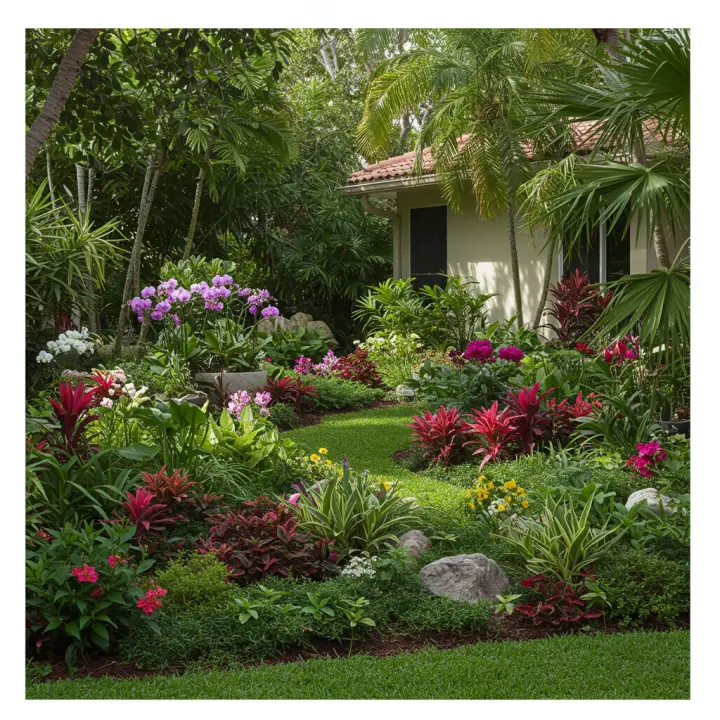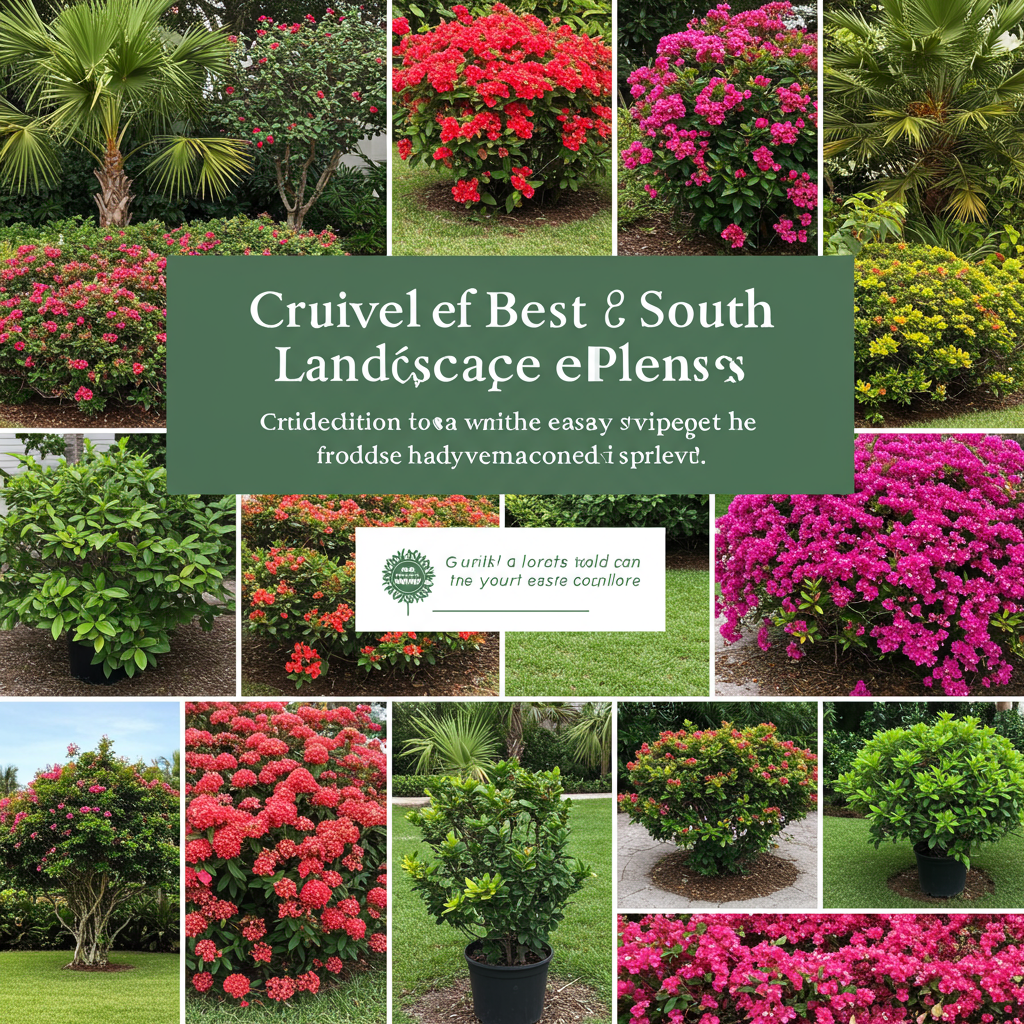Discover the best South Florida landscape plants that combine breathtaking beauty with effortless maintenance, ensuring your garden flourishes in the unique tropical climate.
Cultivating Your Tropical Oasis with Ease

South Florida boasts a unique and vibrant environment, offering the perfect backdrop for a stunning tropical garden. However, choosing the right plants can be the key to success – or frustration. Understanding which species not only thrive in our specific heat, humidity, and soil but also require minimal fuss is essential for any homeowner. This guide will walk you through top-performing South Florida landscape plants that promise both dazzling aesthetics and surprisingly easy care, transforming your outdoor space into a slice of paradise without the constant upkeep.
Why Choose Florida-Friendly & Native Plants?
Opting for plants that are naturally suited to our climate dramatically reduces the effort needed to keep them healthy. Florida-friendly plants are selected for their ability to thrive with minimal irrigation, fertilizer, and pesticides once established. Native plants go a step further, having evolved in the region for centuries, making them perfectly adapted to local conditions and beneficial to wildlife.
Thriving in the Tropical Climate
These plants are naturally resilient to South Florida’s high temperatures, humidity, and summer rainfall. They often possess built-in defenses against common local pests and diseases, meaning less intervention from you.
Reduced Maintenance & Water Needs
Once established, Florida-friendly and native plants typically require less watering than non-native alternatives. This saves you time, effort, and money on your utility bills, contributing to a more sustainable landscape.
Supporting Local Wildlife
Many native plants provide essential food and shelter for birds, butterflies, bees, and other beneficial creatures, helping to maintain our local ecosystem’s health and biodiversity.
Top Picks for Stunning & Easy South Florida Landscape Plants
Let’s dive into some of the most rewarding plants that will make your South Florida garden shine with minimal effort.
Effortless Beauty: Trees for Your Tropical Oasis
Trees provide essential shade, structure, and a dramatic focal point for any landscape.
Gumbo Limbo (Bursera simaruba): Often called the “Tourist Tree” due to its peeling, red bark, this native is incredibly tough, hurricane-resistant, and drought-tolerant. It offers unique visual interest and grows quickly.
Live Oak (Quercus virginiana): A classic, majestic native tree providing dense shade and a long lifespan. While slower growing, its beauty and ecological value are unmatched. Tolerates salt spray well.
Geiger Tree (Cordia sebestena): Known for its vibrant orange, trumpet-shaped flowers that bloom year-round, the Geiger tree is a stunning addition. It’s relatively salt-tolerant and moderately sized, making it suitable for many yards.
Royal Poinciana (Delonix regia) – Choose wisely for size: While large, the explosive, fiery red-orange blooms of the Royal Poinciana are breathtaking in summer. It’s deciduous, losing leaves in winter, but the flower display is truly magnificent if you have the space.
Vibrant Hues: Shrubs That Bloom & Beautify
Shrubs offer continuous color, define spaces, and provide privacy.
Ixora (Ixora coccinea): A popular choice for its clusters of red, pink, orange, or yellow flowers that bloom nearly all year. It thrives in full sun and comes in various sizes, from dwarf varieties to larger hedges.
Firebush (Hamelia patens): A native, fast-growing shrub with bright orange-red tubular flowers that attract hummingbirds and butterflies. It’s remarkably drought-tolerant once established and provides continuous color.
Hibiscus (Hibiscus rosa-sinensis): Famous for its large, showy flowers in a rainbow of colors. While some varieties require more care, many are tough and prolific bloomers, perfect for a sunny spot.
Coontie (Zamia integrifolia): Florida’s only native cycad, this ancient plant is extremely drought-tolerant and virtually indestructible. Its fern-like foliage adds a prehistoric texture and it’s a host plant for the Atala butterfly.
Dwarf Bottlebrush (Callistemon spp.): These evergreen shrubs produce unique, brush-like red flowers that attract pollinators. They are hardy, drought-tolerant, and require minimal pruning.
Ground Covers & Accent Plants for Lush Greenery
Ground covers fill in gaps, suppress weeds, and add texture. Accent plants provide unique interest.
Lantana (Lantana camara / Lantana montevidensis): A versatile, tough plant with clusters of small, colorful flowers (yellow, orange, pink, purple). It’s incredibly drought-tolerant and attracts butterflies. Can be a groundcover or mounding shrub. Note: some varieties are non-native and can be aggressive; choose sterile or native cultivars.
Mondo Grass (Ophiopogon japonicus): A hardy, low-growing grass-like plant perfect for shaded areas or as a border. It’s very low maintenance and tolerates a range of conditions.
Bulbine (Bulbine frutescens): This succulent-like plant produces delicate yellow or orange flower spikes intermittently throughout the year. It’s incredibly drought-tolerant and perfect for sunny, dry spots.
Sunshine Mimosa (Mimosa strigillosa): A fantastic native groundcover that spreads quickly and produces adorable pink puffball flowers. It’s extremely drought-tolerant and can handle foot traffic.
Cordyline (Cordyline fruticosa): Known for its striking sword-like foliage in shades of green, red, pink, and purple, Cordyline adds dramatic vertical interest. It’s relatively easy to care for and tolerates partial shade.
Dazzling Flowers & Perennials for Continuous Color
For splashes of vibrant color that return year after year.
Pentas (Pentas lanceolata): Often called “Egyptian Starcluster,” Pentas produces clusters of star-shaped flowers in pink, red, purple, and white. They are butterfly magnets and bloom almost continuously in warm weather.
Tropical Salvia (Salvia coccinea / ‘Brazillian Red’): These Salvias offer spikes of brilliant red, pink, or white flowers that are irresistible to hummingbirds. They are drought-tolerant and reseed easily.
Mandevilla (Mandevilla spp.): A beautiful vining plant with large, trumpet-shaped flowers in pink, red, or white. It thrives in full sun to partial shade and can be grown on a trellis or in hanging baskets.
Gaillardia (Gaillardia pulchella): Also known as Blanket Flower, this native wildflower boasts cheerful red and yellow daisy-like flowers. It’s extremely drought-tolerant, loves full sun, and reseed readily.
Designing Your Easy-Care South Florida Garden
Strategic planning is crucial for a low-maintenance landscape.
Consider Sunlight & Soil
Before planting, observe your yard throughout the day to understand sun exposure. Test your soil to determine its composition and pH. South Florida soils often vary from sandy to rocky or mucky. Matching plants to these conditions is vital.
Grouping Plants by Water Needs (Hydrozoning)
Place plants with similar watering requirements together. This allows you to irrigate more efficiently, giving thirsty plants more water while avoiding overwatering drought-tolerant species.
Mulch for Success
Apply a 2-3 inch layer of organic mulch (like pine bark, melaleuca, or cypress mulch) around your plants. Mulch helps retain soil moisture, suppresses weeds, and regulates soil temperature, significantly reducing your watering and weeding tasks.
Frequently Asked Questions (FAQs) About South Florida Landscape Plants
What makes a plant “easy” in South Florida?
An “easy” plant in South Florida typically means it’s well-adapted to the local climate (heat, humidity, rainfall, soil), resistant to common pests and diseases, and requires minimal watering, fertilizing, or pruning once established.
Do I need to water native plants often?
Once established, most native plants are highly drought-tolerant and require little to no supplemental watering, especially during the rainy season. During prolonged dry spells or establishment, they might need occasional water.
Can I grow vegetables in South Florida?
Yes! Many vegetables thrive in South Florida, especially during the cooler dry season (fall through spring). Some heat-tolerant varieties can even grow in summer. Raised beds are often recommended due to soil conditions.
How often should I fertilize these easy-care plants?
Many Florida-friendly and native plants require very little fertilizer, especially if your soil is healthy and you use organic mulch. If fertilizing, use a slow-release, granular fertilizer designed for tropical plants, typically once or twice a year in spring and fall. Always follow product instructions.
What’s the best time to plant in South Florida?
The best time to plant in South Florida is generally during the cooler, drier months from October to May. This allows plants to establish their root systems before the intense heat and heavy rains of summer arrive, reducing transplant shock.
Conclusion
Creating a beautiful and easy-to-maintain garden in South Florida is entirely achievable when you choose the right plants. By embracing South Florida landscape plants that are naturally suited to our unique climate, you can cultivate a stunning outdoor space that thrives with minimal input from you. From resilient trees and vibrant shrubs to colorful groundcovers and prolific flowers, the options are abundant. Start by assessing your space, selecting a few of these remarkable plants, and watch as your garden transforms into a truly exceptional, low-effort tropical paradise.

